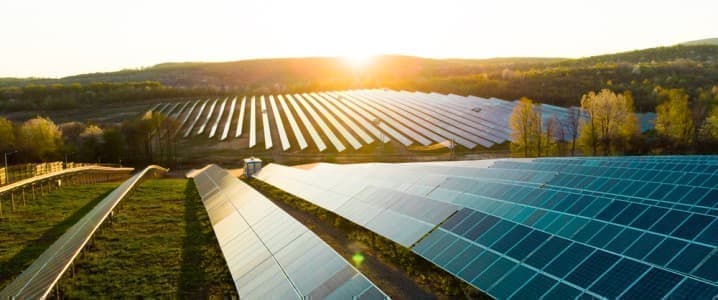Rystad Energy’s latest data reveals renewable energy installations in India surged to a record 7.1 gigawatts (GW) in March, more than doubling the previous record of 3.5 GW set in March 2022. The increase in installations helped India reach its highest-ever annual installed capacity of 18.5 GW for the fiscal year ending on 31 March 2024.
The growth was primarily driven by solar installations, up 23% on levels from the 2023 financial year, driven by the commissioning of numerous projects within India's inter-state transmission system network and ultra-mega solar park schemes. In particular, states such as Gujarat, Rajasthan, Madhya Pradesh and Maharashtra have contributed to this expansion. Notably, Adani Green, the renewable energy arm of Indian conglomerate Adani Group, made significant strides in the first quarter of 2024 by installing approximately 1.6 GW of solar capacity in the Kutch district of Gujarat. This initiative is part of a wider hybrid renewable energy park that will see up to 30 GW of combined solar and wind capacity installed in Khavda in the coming years.
Despite the record growth in renewable energy additions in the recent financial year, India still faces considerable challenges in boosting capacity. In early 2024, the Indian government advanced its renewable energy goal to achieve 500 GW of non-fossil fuel capacity by 2031-32, in line with Prime Minister Modi’s vision of a self-sufficient India aiming for net-zero emissions by 2070.
To achieve the 500 GW target, India must install around 30 GW of non-fossil fuel energy generation capacity annually, which includes solar PV, hydropower, onshore wind and nuclear energy. While the recent increase in renewable capacity is encouraging, further additions are imperative to meet the 2032 goal.
With the commencement of India’s general elections earlier this month, the country’s emphasis on renewable energy comes as no surprise. Despite ambitious climate goals to reduce carbon dioxide emissions, achieving them is only achievable if the country maintains the fervor witnessed in recent months. However, critical challenges persist: ensuring grid stability alongside the higher integration costs that come with introducing more renewable capacity. A strategic solution lies in balancing this clean energy embrace with targeted exports, enabling India’s growth visions for the power sector, without compromising national climate goals."
Rohit Pradeep Patel, Vice President of Renewables and Power Research, Rystad Energy
Learn more with Rystad Energy’s Renewables & Power Solution.
On the supply chain side, the ramp-up of solar installations in India has created substantial demand for solar equipment. Of the record 7.1 GW of renewable capacity added in March, more than 6.2 GW was new solar additions. To put this into perspective, the entirety of 2023 saw 7.5 GW of new solar capacity installed.
Historically, Indian developers heavily relied on Chinese imports due to their competitive pricing over domestic manufacturers. In response, initiatives like the Production Linked Incentive (PLI) scheme were introduced to empower domestic manufacturers to boost their production capabilities, thus enhancing their price competitiveness to meet local demand. Additionally, governmental support measures like the Approved List of Models and Manufacturers (ALMM) mandate and the basic customs duty on imported solar modules further assisted in bolstering the domestic solar industry.
Fueled by its growing solar panel production capacity, hitting 68 GW as of March 2024, India looked to expand its reach by exporting panels. The US emerged as a major export destination due to its high demand for solar energy and the potential for strong profit margins. The Uyghur Forced Labor Prevention Act (UFLPA) in the US also played a role in this shift towards Indian exports.
Despite millions of panels being shipped from India to the US, demonstrating the country's export potential, Indian manufacturers encounter stiff competition from their Southeast Asian counterparts, who maintain an edge by utilizing material inputs from China, resulting in lower costs.
This makes it difficult for India to compete effectively as an exporter, signaling a need to shift focus towards its own domestic solar energy targets rather than prioritizing exports. However, exports from India are expected to increase as the US imposes duties on panels from Southeast Asian counterparts, which are expected to be as high as 254% and set to be implemented from June 2024, making these panels significantly costlier than ones from India.
India presently exports some power to Bangladesh, Nepal and Bhutan, with minor amounts reaching Myanmar. Yet, analyses indicate that India is contemplating future renewable power trading. This involves establishing multiple interconnector projects, linking with nations like the UAE and Saudi Arabia in the Middle East, Sri Lanka to the south and the Myanmar-Thailand connection in the east. There is also potential for further expansion in Southeast Asia with Singapore.
However, the realization of this potential is not slated until the 2030s due to the capital-intensive nature of interconnector projects, particularly those involving subsea cables with construction alone spanning four to five years. As a result, India's renewable focus until 2032 will likely revolve around meeting ambitious domestic targets, with minimal short-term impact on accelerating energy transition beyond its borders.
More Top Reads From Oilprice.com:
- Tesla Investors Brace for Worst Financial Report in 7 Years
- IMF Praises UK's Digital Infrastructure for AI Readiness
- Ukraine Looks to Turn the Tide Against Russia with Fresh U.S. Aid


















